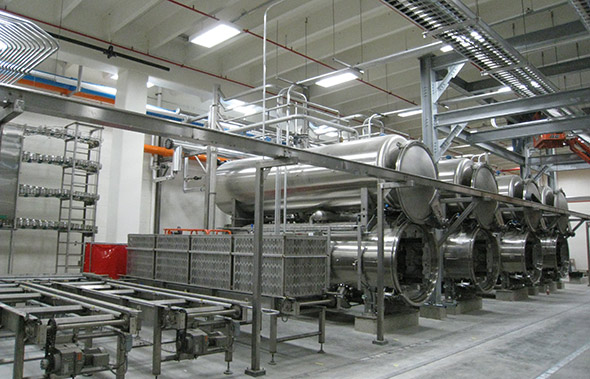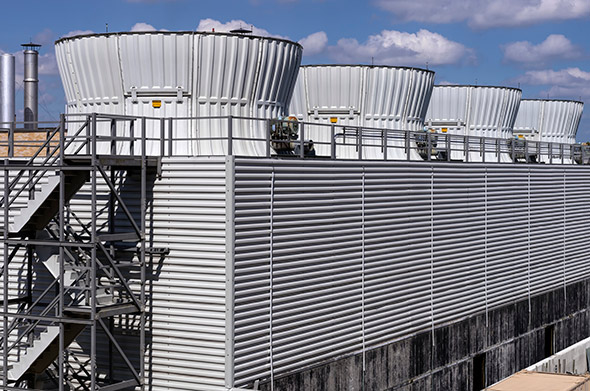Engineering projects
Single source services save time and money for food manufacturers
Capital projects executed by a single firm simplify management and improve execution as shown in this batch retort system design

Figure 1: Multidiscipline engineering firms can examine a project from all perspectives before and during design work to suggest innovations and improvements. Photo courtesy of Matrix Technologies
When a process manufacturer decides to undertake a capital project, one of the first decisions is whether to use one or multiple firms to provide the required engineering services. This article will examine the issues involved with the multiple firm approach, and then show why selecting a single firm is often a better choice, as shown with the successful design and commissioning of a batch retort system.
Problems with multiple service providers
Any owner commencing a capital project must decide what level of outside services will be required. Most process manufacturers will not have all of the required capabilities in house, especially for projects requiring multidiscipline engineering. Even if a company does have all the required engineering expertise in house, these personnel are often busy with their main task of keeping the plant up and running.
Once a decision is made to outsource engineering services, the owner must decide whether to use one firm or many. If multiple firms are selected, management and coordination activities among these groups must be performed throughout the project by the owner itself or by another entity acting as the owner’s representative.
When many parties are involved, it is often difficult to decide just where design improvements can be made because one firm’s idea may save money for their part of the project, while introducing even more costs to another area. It can also be problematic to determine just where each firm’s scope of work begins and ends. Overlaps are costly and require decisions to be made by the owner as to what firm should do the work, while gaps must often be filled with change orders. If problems arise, which is inevitable for a project of any significant size, then the owner must determine just who was at fault, with each firm often pointing fingers at the others.
Given these difficulties, many owners would prefer the single source approach, retaining one multidiscipline engineering firm to provide all of the services required for the project. But this can be easier said than done for capital projects with a significant automation component because many traditional multidiscipline engineering firms are not particularly strong when it comes to automation and system integration.
Multidiscipline engineering addresses issues
The retort to this dilemma is engaging a multidiscipline engineering firm with roots in automation and system integration, staffed with personnel versed in the other disciplines.
An engineering firm with the right experience and skill mix will address the issues detailed above, while providing other benefits. Owner representatives can discuss project improvements up front with the engineering firm’s personnel, confident in the firm’s ability to take a holistic look at any opportunities (Figure 1). From the owner’s perspective, there will be no overlap or gaps among multiple firms to worry about, and if a problem does arise, there is just one firm to work with for resolution.
Single-source suppliers of mechanical, process, civil, structural, architectural, and electrical engineering services can thus act as a one-stop shop for the execution of capital projects. These coordinated services are particularly helpful for manufacturing companies in the food and beverage industry that need to execute complex projects, as shown in the following example.
Single source simplifies execution
One of the largest retail private-label soup manufacturers in the United States engaged Matrix Technologies multidiscipline engineering firm headquartered in Ohio, to design and commission an automated batch retort (ABR) cook room. This expansion would use industrial cookers purchased by the owner beforehand, and it required a new high-speed soup line with canning at 1500 containers per minute to accommodate growing demand (Figure 2).
 |
| Figure 2: Growing demand prompted a soup manufacturer to significantly increase capacity. Photo courtesy of Matrix Technologies |
Matrix engineers were responsible for all aspects of process design, including material flow diagrams, process & instrumentation diagrams, and equipment specifications for the retort cooling system. The firm’s engineers designed foundations for the nine retorts, shuttle rail, unloading lifting device, sump structure, cooling tower, storage tank foundations, and HVAC system—along with all the necessary support structures.
Completing these tasks required engineers from the firm’s civil, process, electrical, and industrial solutions groups to work together. Matrix was able to keep costs low by providing an onsite construction manager to supervise and coordinate all contractors. In addition to keeping the project running smoothly, the presence of a single onsite contact saved the manufacturer time by eliminating the need for them to work with multiple contractors, while ensuring smooth communications among all parties.
Innovative improvements
During the process of designing the ABR for this soup manufacturer, Matrix engineers saved time and money by applying novel approaches to optimize communication among automation devices, and to close the can cooling loop.
Optimize communication among automation devices
ABR automation engineering activities included programming and configuration of programmable logic controllers (PLCs), human machine interfaces (HMIs), and variable frequency drives (VFDs) for the cooling tower system and conveyors.
Matrix engineers were able to use the existing Ethernet network, allowing placement of the PLCs and VFDs out at the cookers, each wired for Ethernet communications. The firm’s engineers were able to expand upon the manufacturer’s existing HMI server system to add more operator stations.
By using the infrastructure the owner already had in place, installation time and expense were greatly reduced, and savings were realized by eliminating the need to develop new communication systems
Close the can cooling loop
To remain compliant with all safety regulations and produce a quality product, soup manufacturers use industrial cookers to guarantee their product is sealed properly, heated to the correct temperature, and cooked efficiently.
To do this, the cooker, once loaded with cans, is filled with water heated to around 285-300°F, then pressurized and cooked for a time. When cooking is completed, these cans must be immediately cooled without releasing pressure too quickly, otherwise the cans might burst.
Increased water consumption of 260 gallons per minute for cookers and coolers caused the company to exceed their permitted level of effluent water due to increased water discharge of 250,000 gallons per day.
The food manufacturer is charged by the city for the water coming in and going out of the plant. In the past, cooling water required by the cooker was constantly being pulled from the city’s supply, used to cool the cans, and released to the drain feeding into the city’s wastewater collection system. While designing this water-intensive process, the design team recognized an opportunity to also cut costs by reusing water.
Matrix designed a system to capture the water used in the cooling process and run it through existing cooling towers. The water is collected from the cooker cooling shell, pumped to the cooling towers, and reused. Water is also collected from the filler can wash stations and sent to cooling tower (Figure 3).
 |
|
Figure 3: Closing the loop on the cooling water system cut water usage, decreased water discharge, and reduced natural gas heating costs. Photo courtesy of Matrix Technologies |
This created a closed loop for water reuse, cutting costs for both the water supply from and the discharge to the city. These activities required considerable automation effort as the 70 cooling tower pumps and fans are each controlled by a VFD linked to the control system network via Ethernet.
The cooling water absorbs the heat energy from the cans, increasing its temperature. A series of heat exchangers, designed by the firm’s engineers, extracts heat energy from the water discharge, which is used to heat other water in various parts of the manufacturing process.
These design improvements not only saved water, but also reduced the manufacturer’s natural gas bills for heating as well. The overall result is significant cost savings and a more environmentally favorable operation.
Conclusion
The soup manufacturer now uses the ABR cooling system as a showcase to demonstrate the level of sophistication and quality in their production operations to their customers.
For this company, and for many other process manufacturers, multidiscipline engineering services provide an effective solution for executing large-scale projects by reducing project management complexity, cutting costs, and encouraging innovation.
For more information, please visit us at https://matrixti.com/multidiscipline-engineering-2/
Looking for a reprint of this article?
From high-res PDFs to custom plaques, order your copy today!





